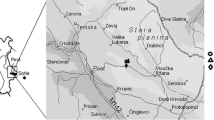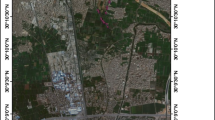Abstract
The study was conducted on six sites that are dominated by Japanese knotweed (Reynoutria japonica) and that vary in the level of industrialization and habitat transformation by humans. The aim of the research was to investigate the chemical-physical features of soil under a closed and dense canopy of R. japonica, the chemical composition of the R. japonica leaves, and to compare the content of certain elements in the soil-plant-soil system. The soil organic carbon (Corg) content varied from 1.38±0.004% to 8.2±0.047% and the maximum in leaves was 49.11±0.090%. The lowest levels of total nitrogen (Ntot) in soil were recorded on the heavily disturbed sites (till 0.227±0.021%). Soil pH varied greatly, ranging from acidic (pH=4.0) to neutral (pH=7.7). Heavy metal content differed significantly among the study sites. At all of the sites, both in the case of soil and plant leaves, Zn was a dominant element and its concentration ranged from 41.5 to 501.2 mg·kg−1 in soils and from 38.6 to 541.7 mg·kg−1 in leaves. Maximum accumulations of P (2103.3±15.3 mg·kg−1) and S (2571.7±17.6 mg·kg−1) were observed on the site that had been influenced by agricultural practices. The results obtained showed that R. japonica is able to accumulate high levels of heavy metals.
Similar content being viewed by others
References
Orians G.H., Site characteristics favoring invasions, In: Mooney H.A., Drake J.A. (Eds.), Ecology of biological invasions of North America and Hawaii, Springer, New York, 1986
Sax D.F., Stachowicz J.J., Brown J.H., Bruno J.F., Dawson M.N., Gaines S.D., et al., Ecological and evolutionary insights from species invasions, Trends Ecol. Evol., 2007, 22, 465–471
Walker L.R., Smith S.D., Impacts of invasive plants on community and ecosystem properties, In: Luken J.O., Thieret J.W. (Eds.), Assessment and management of plant invasions, Springer-Verlag, New York, 1996
Dassonville N., Vanderhoeven S., Vanparys V., Hayez M., Gruber W., Meerts P., Impacts of alien invasive plants on soil nutrients are correlated with initial site conditions in NW Europe, Oecologia, 2008, 157, 131–140
Ehrenfeld J.G., Effects of exotic plant invasions on soil nutrient cycling processes, Ecosystems, 2003, 6, 503–523
Haubensak K.A., D’Antonio C.M., Alexander J., Effects of nitrogen-fixing shrubs in Washington and coastal California, Weed Technol., 2004, 18, 1475–1479
Hawkes C.V., Wren I.F., Herman D.J., Firestone M.K., Plant invasion alters nitrogen cycling by modifying the soil nitrifying community, Ecol. Lett., 2005, 8, 976–985
Simon E., Vidic A., Braun M., Fábián I., Tóthmérész B., Trace element concentrations in soils along urbanization gradients in the city of Wien, Austria, Environ. Sci. Pollut. Res., 2013, 20, 917–924
Saggar S., McIntosh P., Hedley C., Knicker H., Changes in soil microbial biomass, metabolic quotient and organic matter turnover under Hieracium pilosella L., Biol. Fertil. Soils, 1999, 30, 232–238
Kourtev P., Ehrenfeld J., Haggblom M., Experimental analysis of the effect of exotic and native plant species on the structure and function of soil microbial communities, Soil Biol. Biochem., 2003, 35, 895–905
Hobbie S., Effects of plant species on nutrient cycling, Trends Ecol. Evol., 1992, 7, 336–339
Milić D., Luković J., Ninkov J., Zeremski-Škorić T., Zorić L., Vasin J., et al., Heavy metal content in halophytic plants from inland and maritime saline areas, Cent. Eur. J. Biol., 2012, 7, 307–317
Pajević S., Borišev M., Rončević S., Vukov D., Igić R., Heavy metal accumulation of Danube river aquatic plants — indication of chemical contamination, Cent. Eur. J. Biol., 2008, 3, 285–294
Rahmonov O., Relation between vegetation and soil in the initial phase of succession in sandy areas, University of Silesia Press, Katowice, 2007
Van Breemen N., Finzi A.C., Plant-soil interaction: ecological aspects and evolutionary implications, Biogeochemistry, 1998, 42, 1–19
Chapuis-Lardy L., Vanderhoeven S., Dassonville N., Koutika L.S., Meerts P., Effect of the exotic invasive plant Solidago gigantea on soil phosphorus status, Biol. Fertil. Soils., 2006, 42, 481–489
Rahmonov O., Malik I., Orczewska A., The influence of Salix acutifolia Willd. on soil formation in sandy areas, Pol. J. Soil Sci., 2004, 37, 77–84
Mummey D.L., Rillig M.C., The invasive plant species Centaurea maculosa alters arbuscular mycorrhizal fungal communities in the field, Plant Soil, 2006, 288, 81–90
Beerling D.J., Huntley B., Bailey J.P., Climate and the distribution of Fallopia japonica: use of an introduced species to test the predictive capacity of response surfaces, J. Veg. Sci., 1995, 6, 269–282
Ohwi J., The flora of Japan, Smithsonian Institution, Washington, 1965
Adachi N., Terashima I., Takahashi M., Central dieback of monoclonal stands of Reynoutria japonica in an early stage of primary succession on Mt. Fuji, Ann. Bot., 1996, 77, 477–486
Tezuka Y., Development of vegetation in relation to soil formation in the volcanic island of Oshima, Izu, Japan, Jpn. J. Bot., 1961, 17, 371–402
Bailey J.P., Conolly A.P., Prize-winners to pariahs — A history of Japanese knotweed s.l. (Polygonaceae) in the British Isles, Watsonia, 2000, 23, 93–110
Conolly A.P., The distribution and history in the British Isles of some alien species of Polygonum and Reynoutria, Watsonia, 1977, 11, 291–311
Tokarska-Guzik B., The establishment and spread of alien plant species (Kenophytes) in the flora of Poland, University of Silesia Press, Katowice, 2005
Beerling D.J., Bailey J.P., Conolly A.P., Fallopia japonica (Houtt.) Ronse Decraene, J. Ecol., 1994, 82, 959–979
Barney J.N., Tharayil N., Di Tommaso A., Bhowmik P., The biology of invasive alien plants in Canada. 5. Polygonum cuspidatum Sieb. & Zucc. [=Fallopia japonica (Houtt.) Ronse Decr.], Can. J. Plant. Sci., 2006, 86, 887–905
Weber E., Invasive plant species of the world. A reference guide to environmental weeds, CABI Publishing, Wallingford-Oxon, 2003
Child L., Wade M., Hathaway S., Strategic invasive plant management, linking policy and practice: a case study of Fallopia japonica in Swansea, South Wales (United Kingdom), In: Brundu G., Brock J., Camarda I., Child L., Wade M. (Eds.), Plant invasions: species ecology and ecosystem management, Bachuys Publishers, Leiden, 2001
Mandák B., Pyšek P., Bímová K., History of the invasion and distribution of Reynoutria taxa in the Czech Republic: a hybrid spreading faster than its parents, Preslia, 2004, 76, 15–64
Pyšek P., Mank B., Francírková T., Prach K., Persistence of stout clonal herbs as invaders in the landscape: a field test of historical records, In: Brundu G., Brock J., Camarda I., Child L., Wade M. (Eds.), Plant invasions: species ecology and ecosystem management, Bachuys Publishers, Leiden, 2001
Hollingsworth M.L., Bailey J.P., Hybridisation and clonal diversity in some introduced Fallopia species (Polygonaceae), Watsonia, 2000, 23, 111–121
Maertz J.C., Blossey B., Nuzzo V., Green frogs show reduced foraging success in habitats invaded by Japanese knotweed, Biodiv. Cons., 2005, 14, 2901–2911
Simon E., Puky M., Braun M., Tóthmérész B., Assessment of the effects of urbanization on trace elements of toe bones, Environ. Monit. Assess., 2012, 184, 5749–5754
Dassonville N., Vanderhoeven S., Gruber W., Meerts P., Invasion by Fallopia japonica increases topsoil mineral nutrient concentration, Ecoscience, 2007, 14, 230–240
Hirose T., Tateno M., Soil nitrogen patterns induced by colonization of Polygonum cuspidatum on Mt. Fuji, Oecologia, 1984, 61, 218–223
Chiba N., Hirose T., Nitrogen acquisition and use in three perennials in the early stage of primary succession, Fun. Ecol., 1993, 7, 287–292
Bednarek R., Dziadowiec H., Pokojska U., Prusinkiewicz Z., The ecological and soil research [Badania ekologiczno-gleboznawcze], Polish Scientific Press, Warszawa, 2004, (in Polish)
Olesik J.W., Elemental Analysis Using ICP-OES and ICP/MS, Anal. Chem., 1991, 63, 12–21
MacNaeidhe F., Procedures and precautions used in sampling techniques and analysis of trace elements in plant matrices, Sci. Total Environ., 1995, 176, 25–31
Markert B., Sample preparation (cleaning, drying, homogenisation) for trace element analysis in plant matrices, Sci. Total Environ., 1995, 176, 45–61
Mizuno N., Takahashi A., Wagatsuma T., Mizuno T., Obata H., Chemical composition of guttation fluid and leaves of Petasites japonicus v. giganteus and Polygonum cuspidatum growing on ultramafic soil, Soil Sci. Plant Nutr., 2002, 48, 451–453
Duda J.J., Freeman D.C., Emlen J.M., Belnap J., Kitchen S.G., Zak J.C., et al., Differences in native soil ecology associated with invasion of the exotic annual chenopod Halogeton glomeratus, Biol. Fertil. Soils, 2003, 38, 72–77
Liao C., Peng R., Luo Y., Zhou X., Wu X., Fang C., et al., Altered ecosystem carbon and nitrogen cycles by plant invasion: a meta-analysis, New Phytol., 2008, 177, 706–714
Vanderhoeven S., Dassonville N., Meerts P., Increased topsoil mineral nutrient concentrations under exotic invasive plants in Belgium, Plant Soil, 2005, 275, 169–179
Palmer J.P., Fallopia japonica (Japanese knotweed) in Wales, In: De Waal L.C., Child L., Wade M., Brock J.H. (Eds.), Ecology and management of invasive riverside plants, John Wiley & Sons, Chichester, 1994
Simon E., Braun M., Vidic A., Bogyó D., Fábián I., Tóthmérész B., Air pollution assessment based on elemental concentration of leaves tissue and foliage dust along an urbanization gradient in Vienna, Environ. Pollut., 2011, 159, 1229–1233
Sołtysiak J., Berchová-Bímová K., Vach M., Brej T., Heavy metals content in the Fallopia genus in Central European Cities — study from Wroclaw and Prague, Acta Bot. Sil., 2011, 7, 209–218
Kabata-Pendias A., Pendias H., Biogeochemia pierwiastków śladowych, Polish Scientific Press, Warszawa, 1993, (in Polish)
Hulina N., Dumija L., Ability of Reynoutria japonica Houtt. (Polygonaceae) to accumulate heavy metals, Period. Biol., 1999, 101, 233–235
Nishizono H., Kubota K., Suzuki S., Ishii F., Accumulation of heavy metals in cell walls of Polygonum cuspidatum roots from metalliferous habitats, Plant Cell Physiol., 1989, 30, 595–598
Tateno M., Hirose T., Nitrification and nitrogen accumulation in the early stages of primary succession on Mt. Fuji, Ecol. Res., 1987, 2, 113–120
Author information
Authors and Affiliations
Corresponding author
About this article
Cite this article
Rahmonov, O., Czylok, A., Orczewska, A. et al. Chemical composition of the leaves of Reynoutria japonica Houtt. and soil features in polluted areas. cent.eur.j.biol. 9, 320–330 (2014). https://doi.org/10.2478/s11535-013-0267-9
Received:
Accepted:
Published:
Issue Date:
DOI: https://doi.org/10.2478/s11535-013-0267-9




